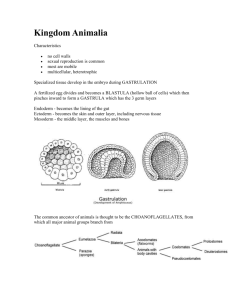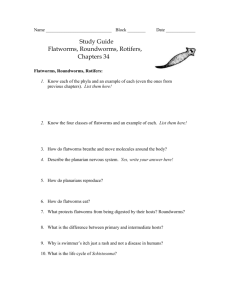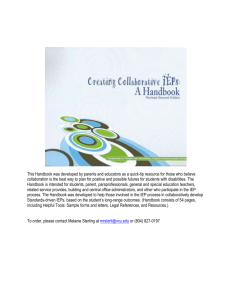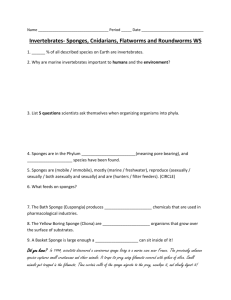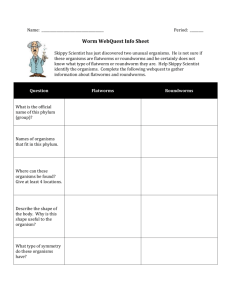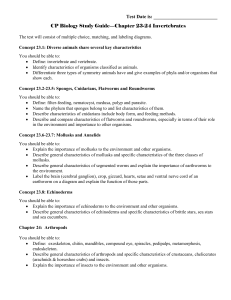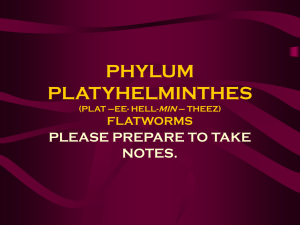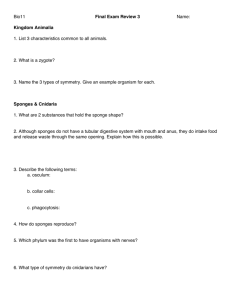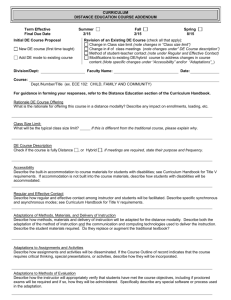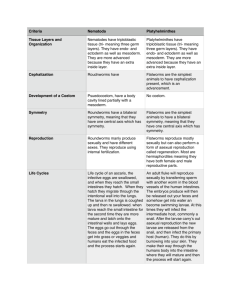FORM #1: LESSON PLAN FORMAT Name: Diana Flasher Date:11
advertisement
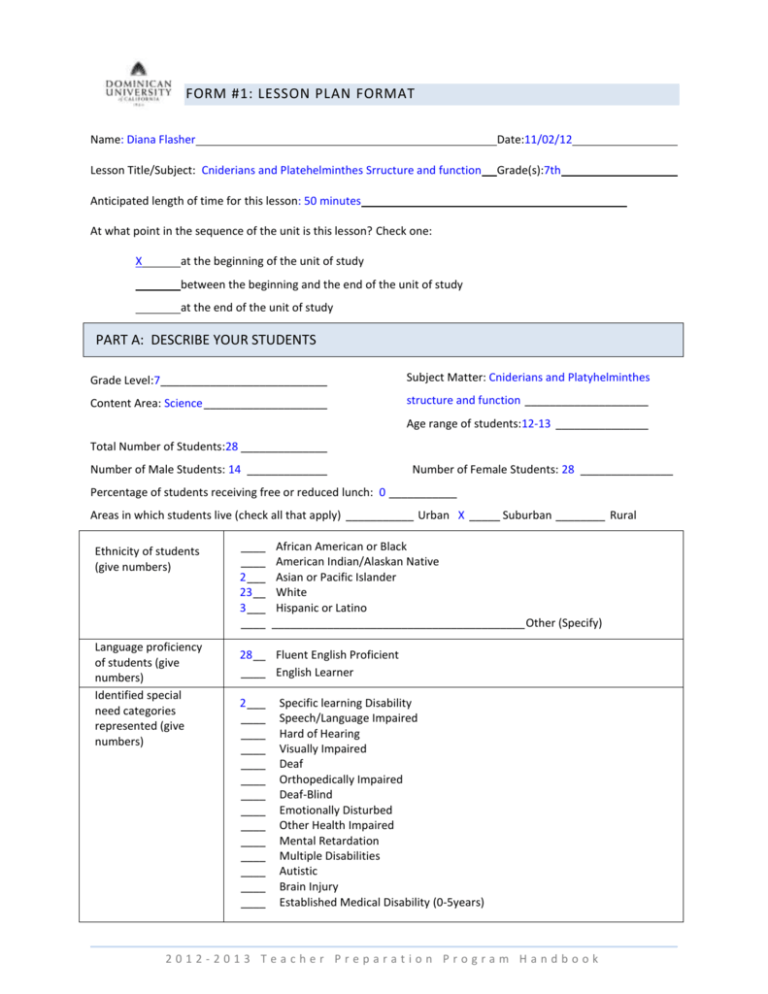
FORM #1: LESSON PLAN FORMAT Name: Diana Flasher Date:11/02/12 Lesson Title/Subject: Cniderians and Platehelminthes Srructure and function Grade(s):7th Anticipated length of time for this lesson: 50 minutes At what point in the sequence of the unit is this lesson? Check one: X at the beginning of the unit of study between the beginning and the end of the unit of study at the end of the unit of study PART A: DESCRIBE YOUR STUDENTS Grade Level:7___________________________ Subject Matter: Cniderians and Platyhelminthes Content Area: Science ____________________ structure and function ____________________ Age range of students:12-13 _______________ Total Number of Students:28 ______________ Number of Male Students: 14 _____________ Number of Female Students: 28 _______________ Percentage of students receiving free or reduced lunch: 0 ___________ Areas in which students live (check all that apply) ___________ Urban X _____ Suburban ________ Rural Ethnicity of students (give numbers) Language proficiency of students (give numbers) Identified special need categories represented (give numbers) ____ ____ 2 ___ 23 __ 3 ___ ____ African American or Black American Indian/Alaskan Native Asian or Pacific Islander White Hispanic or Latino _________________________________________ Other (Specify) 28 __ Fluent English Proficient ____ English Learner 2 ___ ____ ____ ____ ____ ____ ____ ____ ____ ____ ____ ____ ____ ____ Specific learning Disability Speech/Language Impaired Hard of Hearing Visually Impaired Deaf Orthopedically Impaired Deaf-Blind Emotionally Disturbed Other Health Impaired Mental Retardation Multiple Disabilities Autistic Brain Injury Established Medical Disability (0-5years) 2012-2013 Teacher Preparation Program Handbook ENGLISH LANGUAGE LEARNER(S): Who are the English language learners in the class? What are their ELD levels according to the CELDT? Student 3 is a native Spanish speaker who is still developing her academic English. STUDENTS with IEPs: Who are the students with IEP goals? List their academic achievement levels in this content area. Student 1 has a “C” in the class and Student 2 has a “B” in the class. OTHER STUDENTS: Which students will require additional support with this lesson? None PART B: LINK THE LESSON TO STANDARDS ACADEMIC CONTENT STANDARD(S): What academic content standard(s) does this lesson address? S.7.2a Students know the difference between the life cycles and reproduction methods of sexual and asexual organisms. S 7.3d Students know how to construct a simple branching diagram to classify living groups of organisms by shared derived characteristics and how to expand the diagram to include fossil organisms. S 7.5a. Students know that plants and animals have levels of organization for structure and function, including cells, tissues, organs, organ systems and the whole organism. UNIT OF STUDY: Describe the UNIT OF STUDY that addresses the standards above. Students learn the structures and functions of the major invertabrate phyla. ELD STANDARD(S): Identify the ELD standards for this subject area that will be addressed in this lesson (listening, speaking, reading and/or writing) for each ELD n your class. Listening and speaking: the students will listen attentively to stories and information and identify important details and concepts by using both verbal and nonverbal responses. Reading: the students will use decoding skills and knowledge of both academic and social vocabulary to read independently. Writing: The students will use basic strategies of note -taking, outlining and the writing process to structure drafts with consistent use of standard grammatical forms. ________________________________________________________________________________________ 2012-2013 Teacher Preparation Program Handbook STUDENTS WITH IEPs: Identify the IEP goals for this subject area that will be addressed in this lesson. Student 1 and 2 will increase their ability to keep a time management system by independently and accurately recording 9 of 10 of their assignments with 85% accuracy, checking when the assignment is completed, marking out the entry when the assignment is turned into the teacher, and highlighting it when it is incomplete. PART C: PLAN THE LESSON ACADEMIC LEARNING GOALS (outcomes/objectives) For This Lesson: What specifically do you expect students to know or be able to do as a result of the lesson? (Goals/outcomes/outcomes must be observable and measurable.) Students will know and understand: how different groups of invertebrates emerged over time. how invertebrates are classified. the relationship between Cniderians’ and Platehelminthes structures and function. the main characteristics and natural history of Cniderians and Platehelminthes how Cniderians and Platehelminthes bodies are organized ________________________________________________________________________________________ LANGUAGE GOALS (outcomes/objectives) For EL learners: What specific behaviors will the students demonstrate to show they have met the ELD standard(s)? (Outcomes must be observable and measurable.) Students will be able to respond accurately to simple questions either with words or thumbs up/thumbs down. Students will be able to read the text independently as shown by their workbook responses. Students will use basic strategies of note-taking to complete the Invertebrate Phyla chart as evidenced by the 2012-2013 Teacher Preparation Program Handbook teacher checking. ________________________________________________________________________________________ STUDENT LEARNING GOALS (outcomes/objectives) for STUDENTS with IEPs: Describe how the Academic Learning Goals will be modified for students with IEPs (if necessary).The learning goals will not be modified. 2012-2013 Teacher Preparation Program Handbook PART D: COMPONENTS OF THIS LESSON Think about the sequence of this lesson. Describe your plans for instruction in the order in which they will be implemented. Under “Instructional Strategies,” explain what you will do to present the content to the students. What will you do/say? Under “Student Activities,” explain what the students will do during instruction. INTRO-INSTRUCTIONAL STRATEGIES: A. How will you hook your students’ interest? State your exact wording. Here is a comic by Gary Larson. It shows what can happen when jellyfish swim to fast. Of course, the humor stems fro the fact that jellyfish move slowly, so, in reality, they would never go crashing into the rocks. B. How will you connect the content of this lesson to prior learning? State your exact wording. You have learned how scientists classify organisms, as well as that many invertebrates emerged during the Paleozoic (Cambrian) Era (about 500 million years ago), and that, through sexual reproduction, the DNA of organisms changed over time. As the DNA changed, organisms developed different instructions and made different body structures with different functions. C. How will you connect the content to the life experiences of your students? Have you ever gone to the beach when the tide is low, and seen sea anemones covering the rocks? How many of you have seen sea anemones at the Monterey Bay Aquarium? D. How will you present the academic learning goals (outcomes/objectives)? State your exact wording Today we are going to learn why certain animals are classified as “Cniderians and Flatworms live and how their structures compliment their functions. I want you to use your critical thinking skills to compare your own structures and functions to that of Cniderians and Flatworms. ________________________________________________________________________________________ INTRO-STUDENT ACTIVITIES: How will students be engaged during the introduction to the lesson? Consider grouping, pair work, guided practice, individual work, etc. Students will correct their “What is an Animal” worksheet. Students will watch a DVD on Sponges, Cniderians and Worms. Students will participate in a discussion about Cniderians and Flatworms. Students will take notes on the chaacteristics of Cniderians and Flatworms. THROUGH-INSTRUCTIONAL STRATEGIES: A. List the steps of your lesson presentation. 2012-2013 Teacher Preparation Program Handbook Students will correct their “What is an Animal” worksheet. I will lead the students in a discussion about Cniderians and Flatworms Students will watch a DVD on Sponges, Cniderians and Worms. Students will take notes on the chaacteristics of Cniderians and Flatworms I will explain the major characteristics of Cniderians and Flatworms. B. What strategies will you use to check for understanding? I will ask the students to explain how Cniderians and Flatworms are more complex animals relative to Sponges. Based on the Geologic Tine Table and the Phylo-genetic chart on page 415, how long do you think Cniderians and Flatworms have been inhabiting the oceans? ________________________________________________________________________________________ Through-Student Activities: How will students be engaged during each part of the lesson? Consider grouping, pair work, guided practice, individual practice; application, etc. Students will correct their “What is an Animal” worksheet. Students will watch a DVD on Sponges, Cniderians and Worms. Students will participate in a discussion about Cniderians and Flatworms. Students will take notes on the chaacteristics of Cniderians and Flatworms. ________________________________________________________________________________________ BEYOND-INSTRUCTIONAL STRATEGIES: A. How will you close the lesson? Next week we will continue to learn about the different invertebrate Phyla and we will start a lab using live flatworms! B. Describe any informal/formal assessments used. Informal: I will ask the students to explain how Cniderians and Flateworms are more complex animals relative to Sponges. Based on the Geologic Tine Table and the Phylo-genetic chart on page 415, how long do you think Cniderians have 2012-2013 Teacher Preparation Program Handbook been inhabiting the oceans? After a student answers the question, I will ask the class for a thumbs up/thumbs down to indicate if they agree. ________________________________________________________________________________________ BEYOND-STUDENT ACTIVITIES: Read the text Chap 11, pages 417 to 427 as you do complete the workbook questions. MATERIALS/TECHNOLOGY/RESOURCES: What materials (supplies, equipment, teaching aids) need to be prepared and available? How will you use aides/volunteers in this lesson Pictures from National Geographic and Gary Larson comic: DVD on Sponges, Cniderians and Worms. 2012-2013 Teacher Preparation Program Handbook PART E: ADAPTATIONS ENGLISH LANGUAGE LEARNERS: Explain how your lesson plan is adapted according to each of the following components of the SIOP model: Preparation, Building Background, Comprehensible Input/Strategies, Interaction, Practice/Application, and Review/Assessment. Student 3 is seated near the document reader screen and teacher. Slow down speech. Ask the student the word for “jellyfish” in Spanish. Explain the structure and function of Cniderians in several ways. Relate the lesson to her experience: ask her if she has ever seen or been stung by a jellyfish or seen a sea anemone in a tidepool. Ask her for a thumbs up if she is understanding the discussion. Ask her to see me at the end of class regarding any workbbok questions. _______________________________________________________________________________________ _______________________________________________________________________________________ STUDENTS with IEPS: List the specific accommodations/adaptations that you have made for your students with IEPs. Explain how these accommodation/adaptations provide access to the Academic Content Standards. Seat students 1 and 2 near the document reader screen and teacher. Check students’ Planner. Check in with students to ask if they any questions about the discussion or assignment. Recommend to them to do the assignment in resource class. Allow extra time to complete assignment. 2012-2013 Teacher Preparation Program Handbook _______________________________________________________________________________________ _______________________________________________________________________________________ Are there other students for whom you want to make adaptations? Explain these adaptations. No. PART F: REFLECTION SELF-EVALUATION: Describe the effectiveness of this lesson in helping students meet the learning goals. Based on the questions asked and the responses by the students to my questions about the big ideas of the lesson, they are achieving the learning goals. I will find out the extent to which they are achieving the learning goals when I give the next quiz. ________________________________________________________________________________________ How will you apply what you have learned when you plan instruction in the future. I will continue to monitor the progress of Students 1,2 and 3 to determine whether or not my adaptations are helping the students to access the curriculum. 2012-2013 Teacher Preparation Program Handbook
